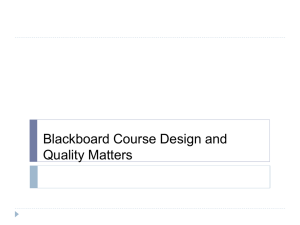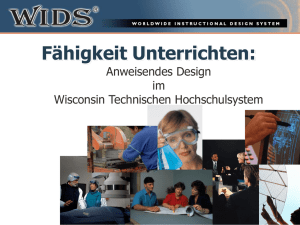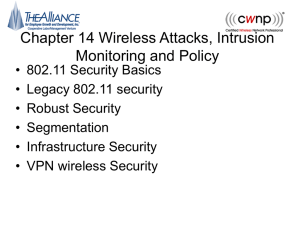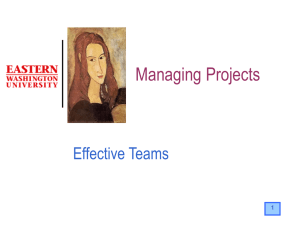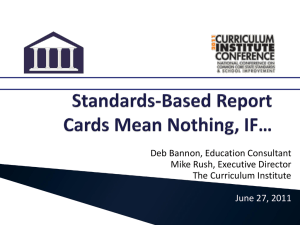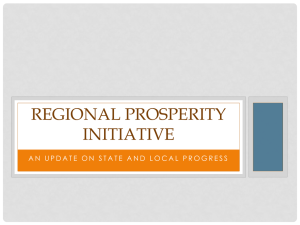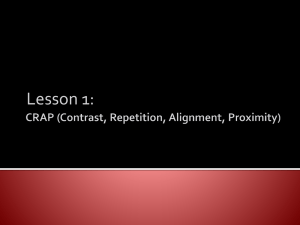Why Align?
advertisement
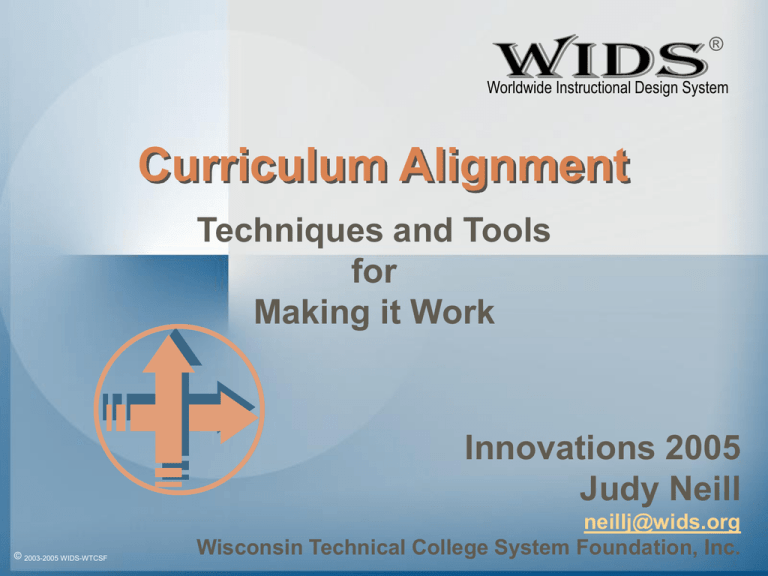
® Worldwide Instructional Design System Curriculum Alignment Techniques and Tools for Making it Work Innovations 2005 Judy Neill © 2003-2005 WIDS-WTCSF neillj@wids.org Wisconsin Technical College System Foundation, Inc. Curriculum Alignment Model Process Tools Products Reflections © 2003-2005 WIDS-WTCSF What does learning alignment mean to you? © 2003-2005 WIDS-WTCSF Learning-Centered Alignment • Focuses on learning • Lays the groundwork for documenting learning results • Sets the stage for teaching and learning excellence • Encourages continuous improvement © WIDS 05 WIDS-WTCSF 2003-2005 Aligned Learning Model All Learning Experiences Courses Programs Majors Degrees © WIDS 05 WIDS-WTCSF 2003-2005 Aligned Learning Model Who? Learners What? Learning Outcome s When? Assessment How? Learning Activitie s © WIDS 05 WIDS-WTCSF 2003-2005 Identify learning needs. Teach the right thing. Assess what we intended to teach. Teach what we intend to measure. Learning Colleges Align Learning. WHO WHAT WHEN HOW © WIDS 05 WIDS-WTCSF 2003-2005 Why Align? Enhance the quality of student learning Ensure national or professional occupational standards are met. Infuse program outcomes. Examine the duplication of course content. Incorporate new content and/or update existing content. Facilitate collaboration among faculty. © WIDS 05 WIDS-WTCSF 2003-2005 Aligned Learning Experience Courses Workshops What Competencies Exit Learning Outcomes Performance Standards Linked External Standards Learning Objectives Aligned When Assessment Activities Learning Activities Rubrics Assessment Items Seminars © WIDS 05 WIDS-WTCSF 2003-2005 How Learning Materials/Objects Delivery Modes Other Learning Experiences Aligned Learning Model Horizontal Alignment College to College © WIDS 05 WIDS-WTCSF 2003-2005 (Transfer) Aligned Learning Model Vertical Alignment Horizontal Alignment Level-to-Level © WIDS 05 WIDS-WTCSF 2003-2005 (Articulation) Aligned Course – Multiple Iterations Within a College Within a Program Title Description Course Number Grading Rationale Aligned Credit Configuration Competencies Exit Learning Performance Outcomes Standards Linked External Standards Across a System © WIDS 05 WIDS-WTCSF 2003-2005 Across a Department Aligned Program– Multiple Iterations Across Across Title Colleges Levels Program Number Description Entrance Requirements Prerequisites Program Outcomes Aligned Competencies Performance Standards Vertical © WIDS 05 WIDS-WTCSF 2003-2005 External Standards Courses •titles • descriptions • credits Horizontal What Isn’t Aligned in Program Alignment – Multiple Iterations? Decisions made by college, department, or individual faculty members. © WIDS 05 WIDS-WTCSF 2003-2005 College Core Abilities Learning objectives Learning activities Assessment activities Delivery mode Course sequence Textbooks Specific General Studies Courses Electives Wisconsin Technical College System Health Occupations Statewide Alignment © 2003-2005 WIDS-WTCSF Wisconsin Health Occupations Alignment Wisconsin Situation All 16 colleges offered Health Occupations programs. Shortage of healthcare workers led to pressure from industry align programs. Programs had different entrance requirements. Programs had different science requirements. Students couldn’t transfer between programs. Expanded online offerings increased issues of transfer/articulation among colleges. © WIDS 05 WIDS-WTCSF 2003-2005 Wisconsin Health Occupations Alignment Wisconsin Goals Boost enrollment in health occupations programs. Ease course transferability among colleges. Facilitate collaboration among faculty state-wide (make use of best practices.) Maximize the use of statewide curriculum development dollars. Facilitate development of online courses. Align programs but allow individual teaching differences in learning objectives, learning activities, textbooks, etc. © WIDS 05 WIDS-WTCSF 2003-2005 Wisconsin Health Occupations Alignment Solution: Aligned Curriculum Same entrance requirements Same program configuration (courses/credits) Same course titles and descriptions Same program outcomes Same course competencies Same performance standards for assessment © WIDS 05 WIDS-WTCSF 2003-2005 Wisconsin Health Occupations Alignment Solution: Aligned Curriculum Anesthesia Technology Health Unit Coordinator Clinical Laboratory Technician Medical Assistant Cardiovascular Technologist (AD, PN, and Nursing Assistant) Dental Assistant Radiography Technologist Dental Hygienist Surgical Technologist Diagnostic Medical Sonography © WIDS 05 WIDS-WTCSF 2003-2005 Medical Coding Nursing Wisconsin Health Occupations Alignment Partnership with WIDS Facilitate alignment process. Define “above the line” and “below the line.” Link to Professional Standards, DACUM, and Program Outcomes. Disseminate and store the curriculum electronically. © WIDS 05 WIDS-WTCSF 2003-2005 Provide a consistent curriculum model, format and terminology. Allow teacher differences in learning plans and assessment tasks. Aligned Core Curriculum– Multiple Programs Across Across Core Skills Colleges Levels Performance Indicators Assessment Approach External Standards Aligned Professional Development “Plug and Play” Learning Activities Implementation Strategies Related Occupations © WIDS 05 WIDS-WTCSF 2003-2005 Horizontal Wisconsin Technical College System Critical Core Manufacturing Skills Statewide Alignment © 2003-2005 WIDS-WTCSF Wisconsin Critical Core Manufacturing Skills Alignment Wisconsin’s Manufacturing Situation WI manufacturers face cost and competition challenges that call for the implementation of new production efficiency measures along with automation and technology strategies. Growing sense of concern about availability of skilled workers. Concerned that manufacturing industry image is making it difficult to recruit and maintain the right workers. Industry called on WI Technical Colleges to help position manufacturing as a continuously vital part of Wisconsin’s economy. © WIDS 05 WIDS-WTCSF 2003-2005 Wisconsin Critical Core Manufacturing Skills Alignment WTCS Critical Core Skills Project Goals Identify high level, critical core skills that are needed by all manufacturing graduates and incumbent workers. Infuse the critical core skills into all Wisconsin Technical College manufacturing programs. Develop strategies for assessing the critical core skills. Provide resources for teaching the critical core skills across the curriculum of all manufacturing programs. © WIDS 05 WIDS-WTCSF 2003-2005 Wisconsin Critical Core Manufacturing Skills Alignment Solution: WTCS Critical Core Skills Industry focus groups to identify the critical core skills. Twelve critical core skills and performance indicators designed to infuse across all manufacturing programs. Portfolio template with plans to go to electronic portfolios. “Plug ‘n Play” LAP’s (Learning Activity Packets). © WIDS 05 WIDS-WTCSF 2003-2005 Wisconsin Critical Core Manufacturing Skills Alignment Partnership with WIDS Provide a consistent curriculum model, format and terminology. Facilitate development of performance indicators. Assist faculty writers in the development of LAP’s. Provide tools and model for designing professional development. © WIDS 05 WIDS-WTCSF 2003-2005 Assist in linking Critical Core Manufacturing Skills to national standards. Develop the portfolio template and research the use of electronic portfolio’s. The Process © WIDS 05 WIDS-WTCSF 2003-2005 DACUM WIDS Learning Design Process Exit learning Outcomes Define high performance. Core Abilities Gen Education Program Establish WHAT learners will learn. Design learning and assessment. Program Level Course Level Competency Learning Objective Learning Activity Learning Assessment Learning Plans Performance Assessments Learning Objective Learning Objective Learning Activity Learning Activity Criteria Assessment Activities Assessment Objects/Items Scoring Guide/Rubrics Learning Objects/Materials Deliver learning and evaluate effectiveness for continual improvement. All Levels The Alignment Process How Long Does It Take? 1 planning day with deans and other decision-makers 3-4 days pre-work by WIDS consultant 3 two-day collaborative faculty sessions (6 days) 3-4 one-hour conference calls with deans/program managers WIDS consultant work before, after, and between sessions © WIDS 05 WIDS-WTCSF 2003-2005 The Alignment Process 1. Establish criteria for the finished product. © WIDS 05 WIDS-WTCSF 2003-2005 The Alignment Process 2. Identify External Standards and Exit Learning Outcomes [Program, General Education, and Core Abilities]. Note: Use accreditation requirements and standards to guide the process Link external standards to competencies and course to lay the groundwork for standards matrices reports. © WIDS 05 WIDS-WTCSF 2003-2005 The Alignment Process 3. 4. 5. Brainstorm general areas of content or skill. Write competencies for each area. Perform final review of competencies. © WIDS 05 WIDS-WTCSF 2003-2005 The Alignment Process 6. Divide competencies into logical segments of learning, determining sequence and scope of competencies. 7. Create courses – competencies, title, descriptions. 8. Assign credits (3-6 competencies per credit). © WIDS 05 WIDS-WTCSF 2003-2005 The Alignment Process 9. 10. 11. © WIDS 05 WIDS-WTCSF 2003-2005 Determine course prerequisites and sequence. Configure into semesters if applicable. Develop performance standards for each competency (criteria and conditions for assessment). The Tools © WIDS 05 WIDS-WTCSF 2003-2005 WIDS Software: Supports the design of learning and assessment. © WIDS 05 WIDS-WTCSF 2003-2005 © WIDS 05 WIDS-WTCSF 2003-2005 Use only the modules that relate to your project Follow color and icon coded flowcharts as you work WIDS Program Design Module Describe program Designate external standards • NLN Standards • MN Nursing Abilities • NCLEX Content Establish exit learning outcomes • Program Outcomes (discipline specific) • Core Abilities (Critical Life Skills) • General Education Outcomes (degree/program level) Configure courses Link outcomes to courses © WIDS 05 WIDS-WTCSF 2003-2005 WIDS Learning Design Module Identify General Course Information Develop Course Level Outcomes • Competencies and Performance Standards • Learning Objectives Link Competencies to Exit Learning Outcomes • Program External Standards • Certification Exam Content (As needed) • Program Outcomes • Core Abilities Build Syllabi Plan Learning Plan Assessment © WIDS 05 WIDS-WTCSF 2003-2005 Use libraries for helpful references © WIDS 05 WIDS-WTCSF 2003-2005 A verb library for writing competencies and other outcomes (Select by Bloom’s domain and level) © WIDS 05 WIDS-WTCSF 2003-2005 A health care library with sample competencies (Includes sample performance standards for assessment) © WIDS 05 WIDS-WTCSF 2003-2005 A performance assessment task library © WIDS 05 WIDS-WTCSF 2003-2005 Pre-designed performance assessment tasks-use “as is” or adapt to your needs © WIDS 05 WIDS-WTCSF 2003-2005 Link program and other outcomes to competencies to infuse them through the learning © WIDS 05 WIDS-WTCSF 2003-2005 What Is Posted? Project reports/issues Discussions Alignment Documents • • • • • • • WIDS Program Files Program File Reports Sample Program Configuration WIDS Course Files Course Outcome Summary Reports WIDS Analyzer Reports Zip Files Model Learning Materials (when available) © WIDS 05 WIDS-WTCSF 2003-2005 The Products © WIDS 05 WIDS-WTCSF 2003-2005 Alignment Documents All aligned programs Program Outcome Matrices Learning Plans Program Profile Course Outcome Summary (Syllabus) Above-the-Line Below-the-Line Developed through eTech for selected programs. Developed by individual colleges for others. © WIDS 05 WIDS-WTCSF 2003-2005 Assessment Tasks Learning Materials/Objects WHAT IF SOMETHING CHANGES? © 2003-2005 WIDS-WTCSF Help! 1. Our standards have changed! 2. We forgot something! 3. We need more time! 4. We have too much time in this class! 5. I can’t figure out how to teach this! © WIDS 05 WIDS-WTCSF 2003-2005 Review Process Facilitate: 1. 2. 3. Conference call with deans annually Conference calls with teachers of individual courses (professional development) at the conclusion of each semester Face-to-face meetings as needed © WIDS 05 WIDS-WTCSF 2003-2005 Reflections © WIDS 05 WIDS-WTCSF 2003-2005 Challenges Achieve consensus among multiple stakeholders with diverse needs and interests Move forward in the face of overt and hidden complexities and risks Produce high quality products (curriculum) that can be deployed on the frontlines of learning Coordinate a process that is effective, affordable, manageable, timely and flexible © WIDS 05 WIDS-WTCSF 2003-2005 Keys to Success © WIDS 05 WIDS-WTCSF 2003-2005 Partnership Informed Commitment Instructional Design System Defined Deliverables Process: Effective, Efficient, Flexible Easy Dissemination Partnership Leadership WTC System Funding 16 Wisconsin Technical Colleges WIDS © WIDS 05 WIDS-WTCSF 2003-2005 Facilitation ID Expertise and Tools Leadership Resources Deployment Informed Commitment Enhancement of learning and increased access for learners will drive the design process. The aligned program will be different from existing programs. The program at each college will change, causing each college to do things differently Faculty members will be likely to teach different courses – perhaps in different ways. The process will be collaborative, focusing on best practices leading to measurable results that can be benchmarked to standards for excellence in learning and teaching. © WIDS 05 WIDS-WTCSF 2003-2005 WIDS Instructional Design System Centers on learning. Based on performance of learning outcomes Incorporates external standards. Links exit learning outcomes (program, general education, and core abilities) to course outcomes and performance standards. Connects learning outcomes to learning and assessment strategies. Provides software tools to support the process. © WIDS 05 WIDS-WTCSF 2003-2005 Defined Deliverables Alignment Deliverables WTCS Alignment Project Program Summary Course Outcome Summaries Project Documents program profile program level learning outcomes program configuration course profile competencies/performance standards linked program level outcomes project criteria work session summaries plan for development of deployment deliverables Deployment Deliverables Online: eTech Face-to-Face: WTCS © WIDS 05 WIDS-WTCSF 2003-2005 Model Learning Plans Model Assessments Model Learning Materials lesson-level outcomes learning activities assessment activities targeted outcomes assessment strategies scoring guides/rubrics interactive learning objects handouts, practice guides presentation materials, text Process: Effective, Efficient, Flexible © WIDS 05 WIDS-WTCSF 2003-2005 Build buy-in Clarify expectations Align curriculum Monitor and review Easy Dissemination CurriculumBank Central source for most current alignment products Easy to access Provides discussion/review forum Easy to update Cost effective © WIDS 05 WIDS-WTCSF 2003-2005 Benefits of Alignment “This is better than the curriculum we had before. Our old curriculum reflected the biases and preferences of our own faculty. This one is based on the best thinking of teachers from 16 colleges!” Nursing Instructor, Western Wisconsin Technical College © WIDS 05 WIDS-WTCSF 2003-2005 Financial Return? “Curriculum used statewide is more costeffective than developing individual programs at each college. An aligned program is easier to evaluate. Competencies are linked to standards. The colleges now submit one curriculum the accrediting agency, jointly.” Kay Tupala, Associate Dean of Health and Public Safety, Northeast Wisconsin Technical College © WIDS 05 WIDS-WTCSF 2003-2005
